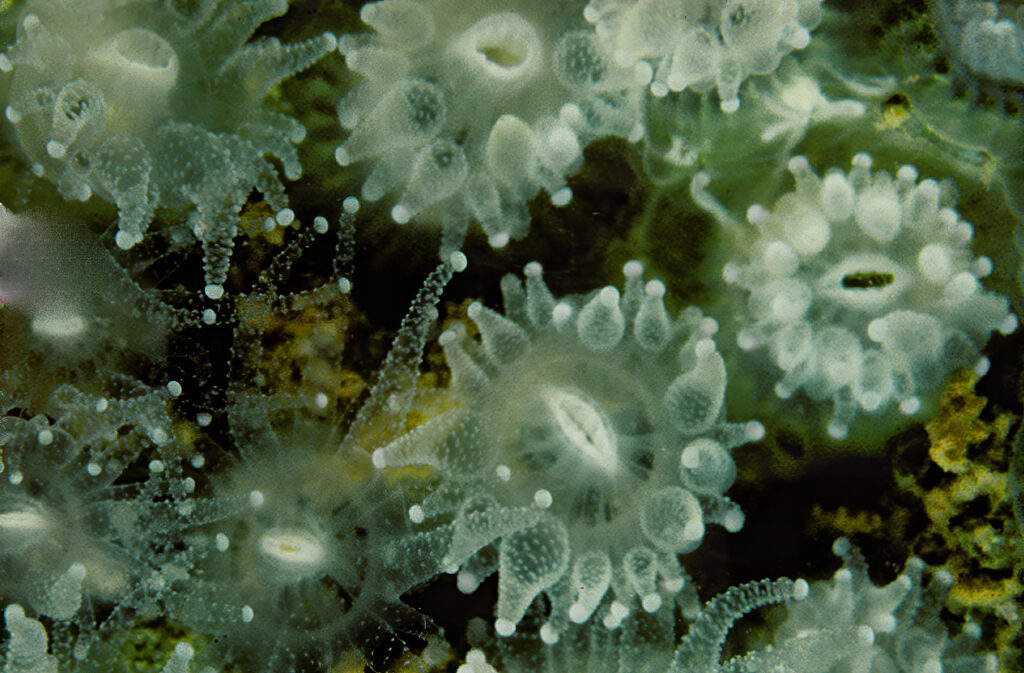Many of Long Island Sound’s beachgoers, scuba divers and boaters may not know that our waters harbor a species of coral, also found in the Caribbean and the west coast of Africa. Even scuba divers that have encountered the tiny, eye-arresting marine creature might not realize that what they have sighted is the northern star coral. The species occupies tropical waters and the Atlantic coast, as far north as Woods Hole, Massachusetts.
Unlike their reef-building tropical cousins, northern star corals are not surrounded by schools of attractively colored fish. The Sound’s stony corals are not reef-builders. They only produce small colonies that barely measure 2 to 6 inches across. They are sometimes said to be no more than the size of a silver dollar. The corals can be found under ledges, on rocks, pilings, oyster shells and shipwrecks. From shore at Milford, Connecticut’s Anchor beach, the coral can be spotted on rocks less than 300 feet from the shore. Some have even been spotted on rocks, in less than three feet of water. The sea bottom at Smithtown Bay (Northport, NY) is covered with small rocks and boulders that frequently house the corals. Boulders surrounding lighthouses are also a likely site for them. The wreck of the tug Celtic, on the east side of Sheffield Island (Norwalk, CT — buoy WR-28) is a great place for divers to spot the corals, along with a host of other fascinating marine creatures that are around the wreck and its sunken barge. However, these habitats are just suggestions. The corals can be located throughout the Sound.

Corals belong to a group of animals called Cnidaria, that include anemones, hydroids and jellyfish. Polyps, the living part of corals, resemble anemones with a mouth at the center, surrounded by a circle of tentacles that are armed with stinging cells. They use the stinging cells for defense and to gather food, microscopic ocean creatures called zooplankton. Unlike anemones, corals produce a skeleton (calcium carbonate). Coral stinging cells do not penetrate human skin, but in tropical waters, beware of fire corals. They can cause skin irritation and a rash that can last several days!
There is an algae (zooxanthellae) that lives inside most reef building tropical corals. Using sunlight, the algae provide its host with much of its food, mainly sugars and amino acids. The coral provides shelter for the algae and its needed carbon dioxide. The relationship helps the coral build its skeleton and provides vibrant colors for the coral. If corals become stressed due to rising sea temperatures or other factors, the corals lose their algae and turn white. The process is called bleaching.
Northern star corals can exist with or without zooxanthellae. When present, the coral polyps are brownish; without the algae, they are colored white. The coral endures freezing winters during which they may go through a dormant period. It also manages the heat of tropical waters and even survives after bleaching. Because of its special characteristics, the “coral has the potential to unlock some of the basic mysteries of coral reefs and resilience to climate change.” As a result, it is being studied as an important climate change indicator and how to protect tropical corals. Research is being carried out at Woods Hole’s Marine Biological Laboratory, Southern Connecticut State University and Rhode Island’s Roger Williams University.
In Rhode Island, the northern star coral was approved by the legislature as an official state emblem. In June, 2025, Gov. Dan McKe signed a bill making it the official state coral.
Long Island Sound is a habitat for many other sea creatures: harbor and gray seals, dolphins, multiple species of fishes and so many other intriguing residents. Its waters are a treasure along our shores.
